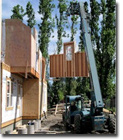 Panelized home producers are the biggest and most diverse segment of U.S. housing market. They include hundreds of conventional panelized producers who sell their packaged homes through builders and builder-dealers. Manufacturers of dome homes and other alternative systems including light-gage steel, lightweight concrete, foam-core panels, foam blocks-plus component firms who cross over into package homes. Panelized home producers are the biggest and most diverse segment of U.S. housing market. They include hundreds of conventional panelized producers who sell their packaged homes through builders and builder-dealers. Manufacturers of dome homes and other alternative systems including light-gage steel, lightweight concrete, foam-core panels, foam blocks-plus component firms who cross over into package homes.
Panelized homes also referred to as "Prefab" have been around for decades. People are just now realizing their true benefits. Panelized construction is simply the process of making wall sections in a factory instead of out at the construction site. Once the panels are finished at the factory they are numbered and then transported to the customer's site.
Depending on the size of the panels, you may need a crane to help you place the panels on the foundation. On the job site, construction time is cut in half because most of the work has been done at the factory; it's just a matter of erecting the panels. On average it takes three to five days for the home's exterior to be finished. This reduces the risk of weather damage and theft from the job site.
Panelized construction seems to attract the do-it-yourself person. The homeowner benefits from a quick move-in date, minimal warping caused by moisture, and cost savings through less waste. The homeowner also has assurance of a product built to closer tolerances just like manufactured and modular homes. Panelized homes may be selected from standard plans or can be customized and designed to fit an individual's needs. Optional features may be chosen, such as window systems, siding systems, shingles, whirlpool tubs and a wide variety of other components.
Please remember that this type of project requires more hands-on as compared to modular or manufactured homes. The homeowner usually acts as the general contractor or helps with certain parts of the building process.
|